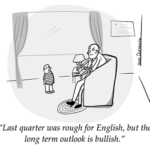Artificial intelligence tools have been in our hands for more than a decade. However, the November 2022 release of ChatGPT-3.5, a chatbot that responds to and generates human-like natural language, sparked new concerns among educators and school leaders. Some school districts, worried that the new technology could undermine teaching and learning, have banned its use. Others are weighing the educational costs and benefits of this tool.
As the debate among educators continues, professional writers are using ChatGPT in a variety of ways. Marketers use it to refine their ad copy. Mystery writers use it to generate plot ideas. Khan Academy founder Sal Khan says it helps him draft grant proposals.
Even when it appears to be the work of a lone creator, most published writing is produced by multiple authors or shaped by the feedback of editors and other writers. Technologies like ChatGPT have become part of this shared activity. As literacy researchers who work with teachers, we urge education leaders to allow students access to ChatGPT. With strategic and informed guidance from teachers, using ChatGPT can allow students to develop important writing skills and practices, like those of professional writers.
Consider what research has revealed about the writing process and instruction. Writing involves complex processes that work together in writers’ minds. These include generating ideas, drafting text, evaluating, editing, and revising (e.g., MacArthur & Graham, 2016). The brain’s executive control mechanisms coordinate these processes, through which writers set goals, make plans to achieve them, and monitor their progress (Zimmerman & Risenberg, 1997). Writers develop these control mechanisms through repeated practice, which takes time to implement in classrooms. However, in classrooms teachers must often spend so much time supporting students in drafting and generating ideas that little is left for setting and monitoring goals, adapting writing plans, and rethinking compositions. Teachers can shift instructional attention to these critical strategic processes by using ChatGPT as a partner.
A partner in the process
Teachers already use technology to help students put thoughts into words. The keyboard bypasses the handwriting that some students find difficult. Digital dictionaries and thesauruses help students choose appropriate and more powerful language. Spell-checkers and other online grammar aids make quick, surface-level edits, so students can focus on substantive revisions.
With teacher guidance, students can use ChatGPT to practice different aspects of the writing process, particularly the strategic and evaluative skills of experienced writers. For example, students can learn how to prompt ChatGPT to generate multiple drafts for different audiences and even in different styles. Students can practice comparing and evaluating those drafts against their individual writing goals. They can compare the effects of different revisions, looking at everything from accuracy of claims to rhetorical power to style to grammar. This practice will enhance their capacity to engage in substantive revision that goes beyond error correction.
With the increased opportunities to practice revision that ChatGPT affords, students can develop an overall understanding of revision and a richer language for talking about writing. Research suggests that using such language enables students to transfer knowledge about writing to new genres and contexts (Yancey, Robertson, & Taczak, 2015). Students can learn not only what to write, but also how to write.
Perhaps ChatGPT’s greatest advantage as a writing partner is that it does not struggle with writing anxiety, nor the ensuing feelings of negative self-efficacy (Klassen, 2002). It is not distractible, and it will never suffer from writers’ block (Rose, 2009). ChatGPT offers judgment-free assistance for students facing a blank page. As such, it can serve as a steady companion for student writers at many stages of development. When students are developing an argument, they can prompt ChatGPT to act as a sparring partner, increasing their interest and motivation. They can use the tool to learn more about types of writing aligned with different professions. For example, the bot can offer samples of the specialized vocabulary used by music reviewers, or the diction and rhetoric of sports commentators.
Students also can use the tool to experiment with different ways of representing emotionally difficult content. In a recent classroom narrative writing assignment, one of our students prompted ChatGPT to generate a third-person version of her autobiographical story about a difficult experience. The student said she found it cathartic to hear her story retold in this way.
Potential dangers
We are aware of the potential dangers of bringing ChatGPT or similar technologies into the classroom. For example, because ChatGPT is trained on data from the internet, it tends to replicate the biases and stereotypes of the data (Walsh, 2020). For this reason, teachers and students will need to examine the language it produces with a critical eye (e.g., Haddix, 2009). For instance, one teacher we know recently found heteronormative and racist bias in stories that ChatGPT generated.
And of course, educators are rightly concerned that this chatbot might become a “cheatbot.” But like Grammarly and spell-checking tools, ChatGPT is here to stay, and we need to learn how to work with it.
Teachers have the expertise to support students in using this tool critically and strategically, as they have with other tools. Students will ultimately learn more about writing if they have access to the same technology that real-world writers use. We urge school leaders to make this tool available in their schools so that teachers can help students become more informed and engaged writers in the classroom and beyond.
References
Haddix, M. (2009). Black boys can write: Challenging dominant framings of African American adolescent males in literacy research. Journal of Adolescent and Adult Literacy, 53 (4), 341-343.
Klassen, R. (2002). Writing in early adolescence: A review of the role of self-efficacy beliefs. Educational Psychology Review, 14 (2), 173-203.
MacArthur, C. & Graham, S. (2016). Writing research from a cognitive perspective. In C. MacArthur, S. Graham, & J. Fitzgerald (Eds.), Handbook of writing research. The Guilford Press.
Rose, M. (2009). Writer’s block: The cognitive dimension. Southern Illinois University Press.
Walsh, B. (2020, July 22). The continuing problem of AI bias. Axios.
Yancey, K.B., Robertson, L., Taczak, K. (2015). Writing across contexts: Transfer, composition, and sites of writing. Utah State University Press.
Zimmerman, B.J. & Risemberg, R. (1997). Becoming a self-regulated writer: A social cognitive perspective. Contemporary Educational Psychology, 22, 73-101.
This article appears in the September 2023 issue of Kappan, Vol. 105, No. 1, pp. 66-67.

ABOUT THE AUTHORS

Sarah W. Beck
SARAH W. BECK is an associate professor of English education and the director of undergraduate studies in the Department of Teaching and Learning at New York University.

Sarah R. Levine
SARAH R. LEVINE is an assistant professor of education at the Stanford University Graduate School of Education, California.










